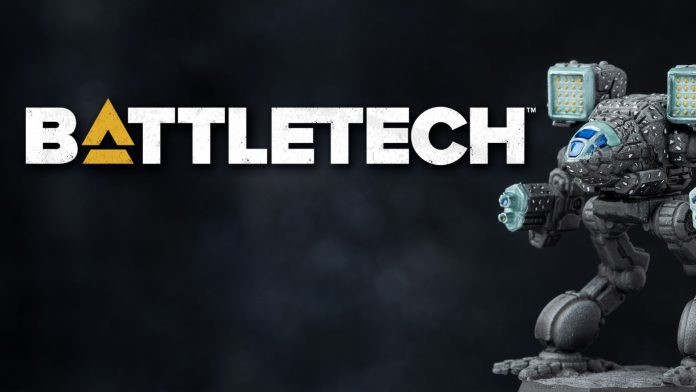As any reader of this column is aware, Classic Battletech (also referred to as the Total Warfare rules) is is a very detailed and crunchy game with substantial information to track. As fun as it is, it does end up getting clunky as you get into larger games. Alpha Strike is a slimmed down set of rules that focuses more on the general performance of a unit rather than modeling each individual medium laser. For 40k players think of Alpha Strike more like Epic or Apocalypse, with the Total Warfare rules as the Warhammer 40k equivalent.
The Alpha Strike rules have existed for years in the Commanders Edition book, and each force pack of minis comes with unit cards, but until now there hasn’t been a starter box specific to the game. The recently released Alpha Strike boxed set comes with nearly everything you need to start playing, missing only an actual playing surface and a tape measure (it’s played with inches and free movement rather than hexes).
Before we get too far into this, I want to thank Catalyst Game Labs for sending over a copy of this box for us to review.

What’s In The Box
This box comes with 13 mechs – five Clan and eight Inner Sphere, giving you two different forces straight out of the box. While not perfectly balanced against each other, they’re close, especially when using the skill levels recommended in the missions included in the quick start rules. Of the included mechs, two are completely new to plastic – the Pouncer on the Clan side, and the Wraith on the Inner Sphere side. Another seven are new variants of existing mechs, with the Warhawk and Fire Moth on the Clan side and the Locust, Wasp, Blackjack, Archer, and Atlas on the Inner Sphere side. The remaining four mechs are existing models, the Nova, Phoenix Hawk, Timber Wolf, and Warhammer. They do, however, come with at least one new variant on each of their unit cards. In addition to the Alpha Strike unit card, each mech has a pilot card that can be used in either Alpha Strike or Total Warfare.
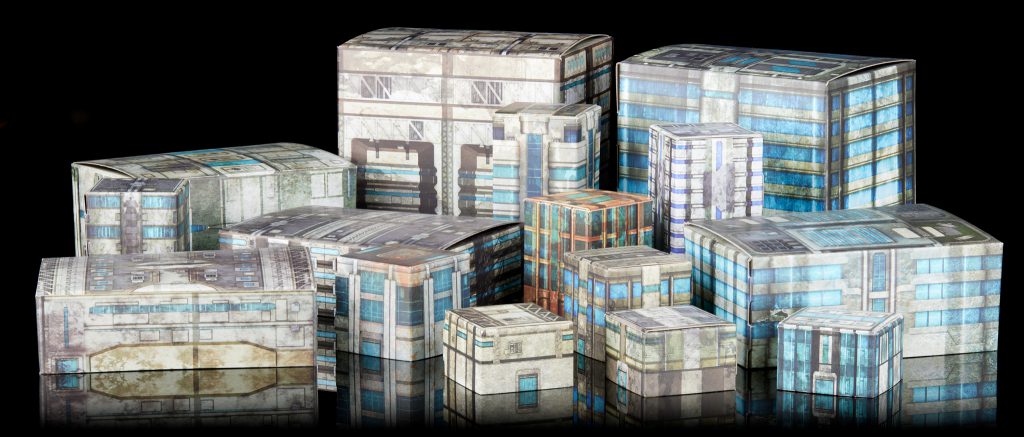
Also included in the box is enough terrain for an entire battlefield. There are 15 fold-up buildings with two different footprints and a variety of different heights, and 10 punch-out card trees. While not tremendously fancy, the terrain looks great and is enough to fill out the recommended 16 terrain pieces the rules call for when setting up a battlefield (a single terrain piece is two of the smaller buildings, one large building, two single trees, or a forest created from between two and four trees to define an area).
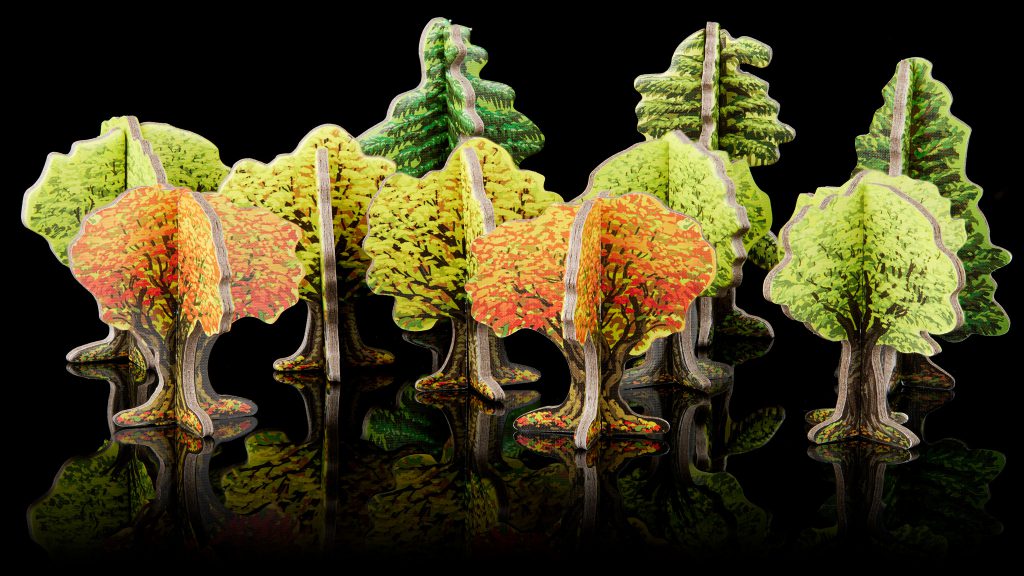
Supplemental to the miniatures and terrain is the quick-start rule book, a deck of battlefield support cards, a set of punch-out tokens to represent movement modifiers, area-of-effect attacks, and objectives, a pair of dice, and a primer for the Battletech universe.
This is a new primer compared to ones included in previous A Game of Armored Combat and Clan Invasion boxes, having progressed the timeline to 3151 and the ilClan era. It covers what the universe is, who the major factions are, and what they’re doing at this point in the timeline. Even as someone familiar with Battletech this is a great quick read that clarifies a lot about what happened between the Clan Invasion and now.
Coming from mostly GW starter boxes this is astounding to me, as it’s actually enough to play satisfying games. The biggest thing is all the included terrain – while it’s nothing fancy actually having enough terrain that you can get set up in a few minutes to play a game means you can go from taking shrink wrap off the box to rolling dice in an incredibly short time. You will need to supply a tape measure (in inches), a surface to play on (4′ x 6′ is the standard recommended size), and optionally a dry-erase marker for the unit cards, but you’re not going to just be stacking up random books and flipping the box over for your play environment.
The Mechs
The core of this game is the mechs, and while you probably could play Alpha Strike using tokens, we’re buying this box to play with the minis. Fortunately, they are pretty good. I love the sculpts, particularly the new Wraith, and the updated variant mechs look great (the posing on the Fire Moth in particular is a big glow-up). The only let-down is that they’re PVC rather than the HIPS you’d get with a GW model, and have softer details and bigger mold lines. It’s nothing you can’t work around, and the mechs do look good, but I’d love to see these same original sculpts cast in higher quality.
One thing to note when you’re getting ready to paint them – my set seemed to have a little bit of mold release on them, so I’d suggest a quick wash with warm water & dish soap before you prime.
Each included unit card has a different mech variant on each side of the card, and can be easily used with dry erase markers as you play the game. To get extra variety out of these mechs, they all have quite a few more variants, all of which are available on the Master Unit List.
Clan Mechs
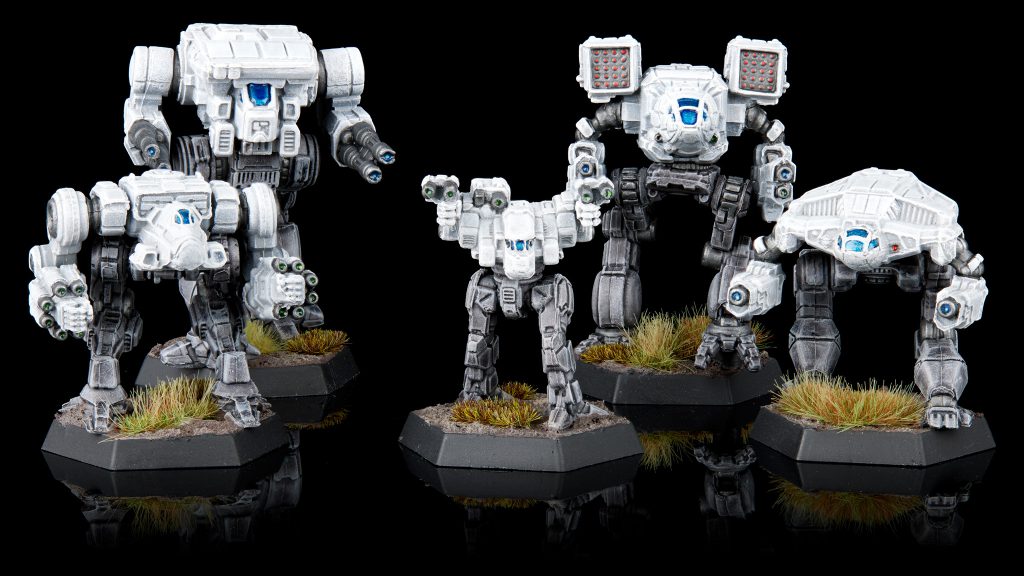
Fire Moth: The lightest included mech, the Fire Moth is astoundingly fast with fairly high damage, though it’s very fragile – with only one point each of armor and structure it’ll die to the lightest of hits. Included are the D and G variants, the G being used in the second scenario. Both variants are nearly the same, with the D being cheaper and a little slower.
Pouncer: New in plastic, the Pouncer is on the light side of medium mechs with decent movement and durability. The Prime variant is a sniper, able to do three damage out to long range, while the T variant has to get closer but can then apply heat to the target.
Nova: A classic Clan mech, both the Nova Prime and T variants fill the same role of being a skirmisher. A little slower but more durable than the Pouncer, it does substantially more damage. The Prime can overheat for astounding damage (tied for the most of any mech in the box), and the T does a little more damage on base without the ability to overheat.
Timber Wolf: We all know the Mad Cat, one of the most iconic mechs of Battletech and Mechwarrior properties after the Clan Invasion era. This box has the Prime, an all-around strong mech with mobility, durability, and firepower both up close and at long range. The other included variant, the T, picks up even more shorter range damage in exchange for being substantially more expensive.
Warhawk: The Warhawk is the biggest included Clan mech (though not the most expensive, the Timber Wolf T takes that trophy). This mech comes with the C and T variants, with the C doing consistent damage out to long range (think of it like two Pouncer Prime’s stapled together), and the T being a closer ranged brawler that can apply heat to the target like the Pouncer T.
Inner Sphere Mechs

Wasp: Absolutely cheap as chips, the Wasp exists primarily to just run around being annoying. The 3W has more structure than armor and does all its damage at short range, while the 5A moves a little faster, has more armor, and while it does less damage it can hit at medium range. In the quick start rules this doesn’t have much of a role beyond being a target, but when you move up to the full rules it becomes useful as a spotter for indirect fire.
Locust: A more functional scout/harasser, the Locust is a bit faster than the Wasp and has a bit more defenses and damage. The 3M has AMS to reduce damage from missiles, and the 7V is quick with damage out to medium range.
Phoenix Hawk: The first of the three Inner Sphere medium mechs, both variants of the Phoenix Hawk are reasonably mobile harassers with real damage dealing ability. Your choice between the 4M and 3K is whether you’d rather have the ability to overheat for more damage at close range or have a bit more damage at long range.
Wraith: The second mech completely new to plastic, the Wraith is broadly a better Phoenix Hawk. While they don’t have any ability to do damage at long range, they’re faster and more durable. The TR5 variant can run 2″ further than the TR1. While it has no in-game effect, it also has an absolutely fantastic model.

Blackjack: A mech familiar to everyone who’s played the HBS video game, the two included Blackjack variants are mirrors of each other. The BJ-3 is a brawler with the most damage up close, and the BJ-5 is a sniper with damage at long range.
Archer: Getting into the heavy mechs, the Archer is fairly slow with solid long range firepower. The 5C is a jack-of-all-trades that doesn’t particularly stand out anywhere, while the 7C is more of a glass cannon. Good damage, can put some damage out in its rear arc if needed, but while it has more armor than the 5C it has very little structure.
Warhammer: A personal favorite, both included Warhammer variants are brawlers with good armor and more firepower at close range than long range. The 8R has more damage and durability than the 6R, but their main difference is really just one of cost.
Atlas: The biggest mech in the box, the two Atlas variants are significantly different. The AS7-S has incredible durability with good short and medium range damage, little long range damage, and like the Archer can shoot into its rear arc. The AS7-S4 is a long range sniper that carries both ECM and Stealth Armor, making it surprisingly hard to hit for such a large and slow mech.
The Quick-Start Rules
The quick-start rules are a 40 page booklet that covers everything you need to play with the units in the box.
It opens with an overview of how to read the unit cards and a quick run through of each included mech, something I find super useful for someone going into this blind. The very simple tips of “keep this moving” or “make use of this mech’s armor” are something I think is great during early playthroughs, as it’ll combat some frustrations of trying to do things “wrong” and set you up for success.
We’ve then got a whole section on terrain and setting up the board. There’s a diagram showing how much terrain should be set up in each section of the board (and how to have two players fairly place it). Combined with actually including enough terrain to play in the box, this will have you playing full games right away. Each different terrain type is then described with how it affects movement, line of sight, and attacks, how big it should be, and some tips for building your own terrain. This is probably the best section on terrain and game boards I’ve seen in any rulebook, and easily smooths out common confusion on what a game board should look out.
Next up we run through all the rules to actually move/shoot/punch. They’re clearly laid out with useful diagrams where needed, and each section steps through the order of a turn nicely. Broadly speaking, these are the same rules that you’ll find in the full rulebook, just removing extraneous rules about working with non-mech unit types and special rules not found on the included mechs.

The first of two included sample scenarios is here just before some of the more advanced rules, using about half the included mechs. It includes specifically what terrain you should use for it, so its easy to get running. After adding rules on buildings and battlefield support, the second scenario adds those to the game, as well as expanding out to run all the mechs included in the box. These two work very well as your first two games, as they’re not doing anything complicated with mission objectives and holding your hands through setting up terrain and extra rules.
Finally, the last few pages of the rules describe how to build your own forces, including using the Master Unit List for mechs and variants not included in the box. Generally speaking, mechs get organized into specific formations, and these rules explain what they are and what rules they’ll grant you.
Between this quick-start book and the MUL (or unit cards included in force packs), you’ve got everything you need to play games with any mech that’s been released, though you may need to ignore some special rules that aren’t included here.
Playing the Game
I rolled out my mat to play some games and my first reaction after finishing the game is surprise at just how slick this ruleset is. Running the first sample scenario took me about 45 minutes from set up to game completion, including plenty of time referring to the rulebook (as it was the first game of Alpha Strike I’ve played) and messing with my camera. I think running it again I’d get down to maybe 20 minutes for a game that size. It goes seriously fast. The second game was a bit slower between doubling mech count and adding buildings, but everything still kept moving quickly.
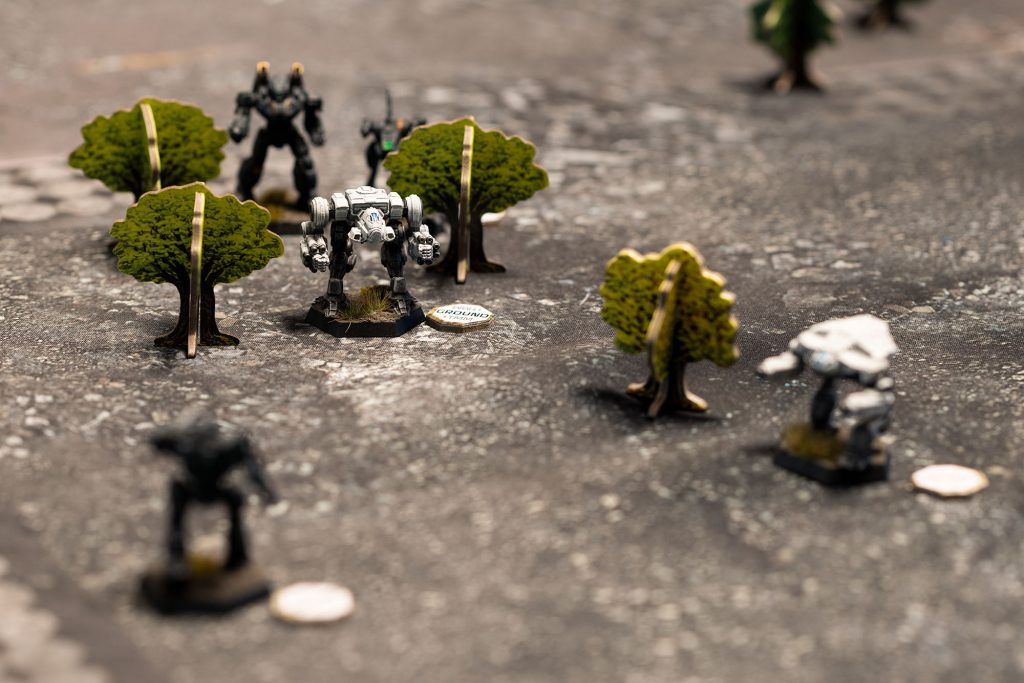
Part of this was due to how attacks and damage works, which might be a little too deadly. The first attack made by the Pouncer killed my Wasp, and through the game there was quite a bit of either a lot of damage happening or none happening. There’s an optional rule where you make a hit roll for each point of damage rather than all in one big lump, and I think that’s something I’ll be using regularly. Having fractional damage makes mechs last a little bit longer, though not significantly, makes you more likely to interact with the crit system, and means a high damage mech might be something you use to try to get just a little bit of damage on something fragile.
With that optional rule being printed right there in the quick-start rules to resolve my only real rules complaint, I think these end up running very well. It’s quick, and while there’s some need to look things up in tables it’s nothing compared to what you need to do in Total Warfare. It also still feels like mechs, which is an accomplishment when you’re simplifying this much.
I’m looking forward to playing more games with this ruleset, as I can easily see that playing company-on-company or larger games are still something you’ll get done in an evening after work. It’s definitely a different feel than Total Warfare, in that it satisfies a desire for mass combat rather than simulationist crunch, but it’s a good feel, and one that has a much lower barrier of complexity.
Final Thoughts
This is probably the best starter box I’ve seen for a minis game. With it including all the terrain you need for a normal sized game and tips for how to create more you’re able to get up and running extremely quickly. The included forces are reasonably balanced against eachother in the included scenarios, and if you keep playing with just the stuff in the box you’ve got quite a bit of variety by swapping mechs and variants around. It’s also a well laid out, full color rule book with a mixture of art and photos of painted minis, something that feels good for setting the mood of the game.
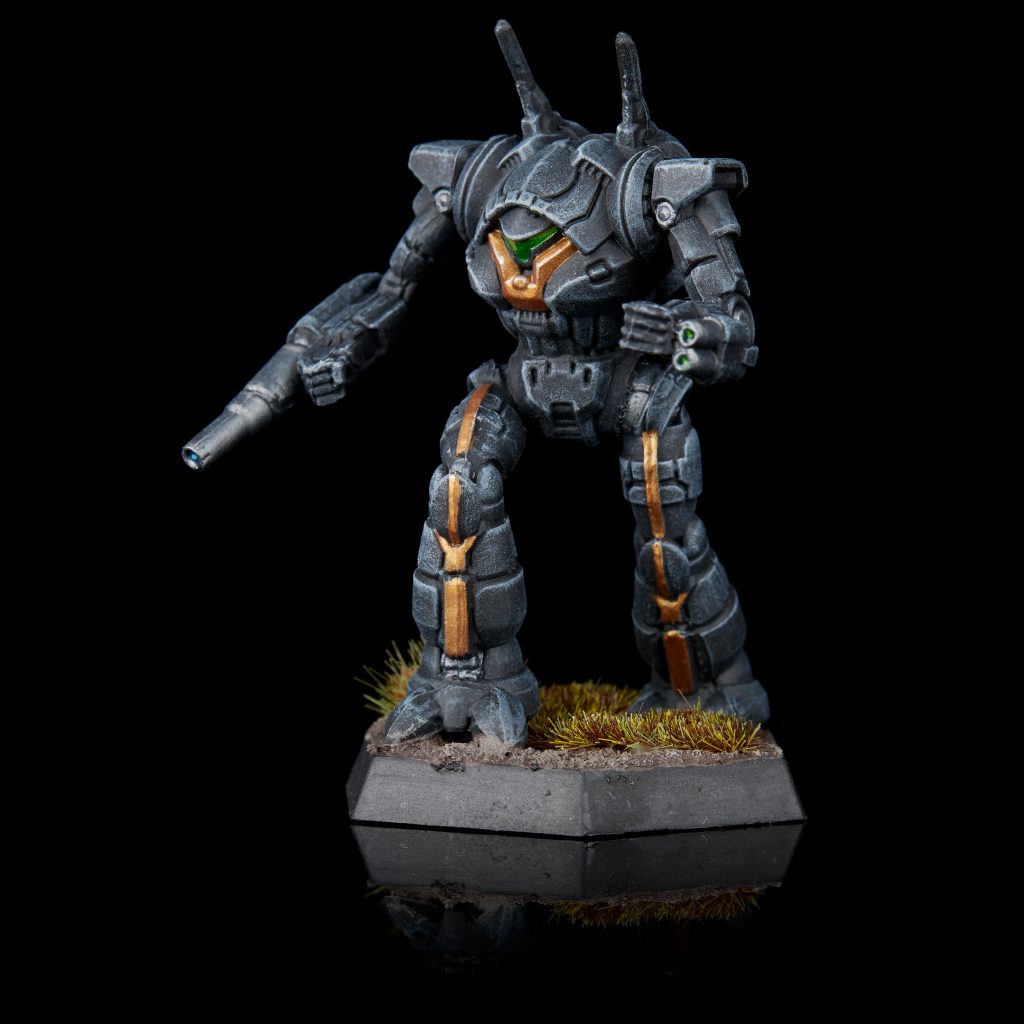
I only have two complaints, both of which are minor. First, I’d love higher quality minis. It would definitely be more expensive, and I get that Catalyst doesn’t have the budget of GW to do HIPS. That’s not to say that these are bad or that there’s anything wrong with them, but as a hobbyist first and gamer second I’m always hoping for the highest quality possible. Second, the 4’x6′ game board is huge, especially for your first game with only 7 mechs. Even with that as the standard size for actual games, I think it would be good have the intros using a smaller board, or some guidelines connecting board size to game size. Being able to fit an entire Total Warfare map on my coffee table or my fairly small dining room table with space for record sheets, rulebooks, and snacks/drinks is something I definitely appreciate about the other ruleset.
Overall, if you’re interested in stompy mechs at all, this is a fantastic purchase. The mechs look good, the rules play well, and everything you need to play is in one box. Expanding out from this my first purchase would be the Alpha Strike Commanders Edition rulebook (or PDF). That book will add more scenarios, terrain types, mech special rules, unit types, and ways to work with formations. Even just with the included 13 mechs that variety can keep you going for a long time, and you can pick up Force Packs with some mechs you find interesting to continue growing your forces.
